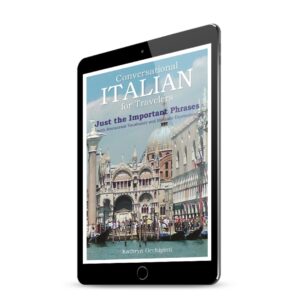Combining the Imperfetto with the Passato Prossimo
Choosing an Italian Past Tense
Let’s start our blog about how to combine the imperfetto with the passato prossimo by reviewing some general rules of Italian grammar. We learned in “Picking an Italian Past Tense” that the circumstances surrounding the event will determine which Italian past tense to use. Luckily, imbedded in many Italian sentences about past events are certain words and phrases that will indicate whether the imperfetto or the passato prossimo is needed. The intent of the speaker will be signaled by these phrases, which will then trigger use of the correct Italian past tense.
To describe a past event in a complex way — in Italian as well as in our native language — we must create a compound sentence. Compound sentences contain more than one phrase separated by commas or conjunctions, such as: and, while, when, but, or. In Italian, to create a compound sentence about a recent past event, we will have to decide which verb tense to use — the imperfetto or passato prossimo.
Of course, when speaking about an event of interest that happened in the recent past, a compound sentence can be created using only the imperfetto or only the passato prossimo, as noted in our last blog. Our focus in this blog will be on the situations that require both the imperfetto and the passato prossimo.
Combine the Imperfetto and Passato Prossimo
with Mentre and Quando
One of the most common reasons to combine the imperfetto and the passato prossimo is to give background information for an action under discussion. In this case, the imperfetto is the past tense of choice to describe the setting and the completed action is relayed with the passato prossimo.
What Italian words or phrases can I use to introduce the setting for a past event?
The setting is defined as the time and place in which an action occurs. Since the imperfetto is used to describe the setting for a past event in Italian, expressions of time in the past are important triggers for the imperfetto.
Some common expressions of past time are given in the tables below using ieri (yesterday), scorso(a) (last), and the preposition da (for). (Note: There are, of course, other meanings for the Italian preposition da. Also, these expressions can also be used with the passato prossimo, but generally additional, more specific information is required, as discussed in our last blog.)
Expressions of Time in the Past with Ieri
| stamattina | this morning |
| ieri | yesterday |
| l’altro ieri | the day before yesterday |
| ieri mattina ieri pomeriggio ieri sera |
yesterday morning yesterday afternoon yesterday evening |
Expressions of Time in the Past with Scorso
| scorso(a) | last |
| la notte scorsa | last night |
| la settimana scorsa | last week |
| il mese scorso | last month |
| l’anno scorso | last year |
| lunedì scorso | last Monday |
| martedì scorso | last Tuesday |
| mercoledì scorso | last Wednesday |
| giovedì scorso | last Thursday |
| venerdì scorso | last Friday |
| sabato scorso | last Saturday |
| domenica scorsa | last Sunday |
Use of “da…” in Italian
| da tempo | for some time |
| da un’ora da due ore ecc. |
for one hour for two hours etc. |
| da un mese da due mesi ecc. |
for one month for two months etc. |
| da un anno da due anni ecc. |
for one year for two years etc. |
The description of the place in which an action occurred can include general interior or exterior surroundings, the weather, or even a prior event. Luckily, language students generally learn the vocabulary to describe various locations early on in their studies, which is also an important first step to learn about any culture. The larger cities and regions in Italy are important to commit to memory. Some common local places where events may take place include at home, at school, at work, or in one of the many shops in the piazza!
How else can I start a phrase to talk about the setting of a past event with the imperfetto?
Mentre, which means “while” in Italian, is a specific sign that a setting or background action is to be relayed in a phrase. Mentre is not required in compound sentences that use both the imperfetto and passato prossimo, but when used it is very helpful. This is because mentre is only used with the imperfetto!
How can use of the imperfetto affect the meaning of a descriptive phrase in Italian?
It is also important to remember that the imperfetto can be translated into English in three ways: the simple past tense, “used to,” or “was/were-ing.” The translation “used to” refers to a habitual action in the the past that is no longer being done. The translation “was/were-ing” is used to describe an action that started in the past but may or may not have been completed.
Just as the Italian present tense can be translated as “I go” or “I am going,” in the past tense, the imperfetto can be translated as, “I went” or “I was going.” For emphasis, one could use stare in both situations to create a compound verb with sto andando (I am going) or stavo andando (I was going). But it is so much easier and so much more common in Italian to use both the simple present tense or the imperfetto past tense without creating a compound verb!
Once I know the setting, about mentre, and about how to relay information using the imperfetto, am I ready to create a compound sentence about the past in Italian?
With all of this in mind… the easiest way to create a compound sentence about the past in Italian is…
Start the first phrase with mentre and give the setting with a verb in the impefetto. Or, just refer to the general time, the weather, or to an action without giving a specific time frame. Note: the descriptive phrase with the imperfetto is often, but not always, the first phrase.
There are, of course, innumerable examples of introductory phrases once can create. Four examples are given below to get us started, with the imperfetto verb underlined.
- Mentre leggevo il giornale stamattina… While I was reading the newspaper this morning…
- Mentre visitavo Firenze l’anno scorso… While I was visiting Florence last year…
- Lunedì scorso, pioveva… Last Monday, it was raining…
- Da due anni abitavo con mia zia… For two years I lived with my aunt…
Now, let’s add a phrase with a completed action to each example above. The passato prossimo is required for this second phrase. See the previous blog, “Picking an Italian Past Tense,” for a short list of Italian verbs that are often used to describe completed actions.
If mentre is not used in the introductory phrase, use quando (when) with the phrase in the passato prossimo. However, quando is not a specific trigger for the passato prossimo phrase, as quando can be used with either the imperfetto or the passato prossimo phrase. The completed action is often, but not always, the second phrase.
Let’s complete the sentences for the first two examples that start with mentre. The passato prossimo verb used in the completed phrase is in green.
- 1. Mentre leggevo il giornale stamatina, la cameriera è arrivato.
While I was reading the newspaper this morning, the maid arrived. - 2. Mentre visitavo Firenze l’anno scorso, ho incontrato Maria per caso al Ristorante Paoli.
While I was visiting Florence last year, I happened to meet Maria at Ristorante Paoli.
Below is our third example that omits mentre in the imperfetto phrase. Notice how quando is used in the passato prossimo phrase that completes the sentence.
- 3. Lunedì scorso, pioveva quando sono andato a trovare mia mamma.
Last Monday, it was raining when I went to visit my mother.
An alternate rendition of the same phrase that uses quando with the imperfetto phrase:
- Quando pioveva lunedì scorso, sono andato a trovare mia mamma.
When it was raining last Monday, I went to visit my mother.
Our final example in a completed sentence:
- 4. Da due anni, abitavo con mia zia quando ho trovato un appartamento perfecto per me.
For two years, I was living with my aunt when I found an apartment perfect for me.
This last example implies the speaker has not yet moved into her new apartment. Remember that if those two years had been completed and the speaker was already in the new apartment, we would need to use the preposition per with the passato prossimo! The introductory phrases would read: “Per due anni, ho abitato con mia zia…” In short, the imperfetto was chosen to give the circumstances of the situation, so the speaker does not have to give the details of where he or she is currently living; this extra information is included with the use of the imperfetto!
Can I put the imperfetto phrase second and the passato prossimo phrase first in a compound sentence?
All four of the example sentences given above work with the phrases reversed. We have already done this with the third example. The first example sentence is reprinted here. Try the rest on your own if you like!
Mentre leggevo il giornale stamatina, la cameriera è arrivato.
While I was reading the newspaper this morning, the maid arrived.
-or-
La cameriera è arrivato mentre leggevo il giornale stamattina.
The maid arrived while I was reading the newspaper this morning.
How do I create a compound sentence about the past in Italian using three phrases?
It is possible in Italian to create a compound sentence in the past tense with more than two phrases, as the case in English (and most every other language). For Italian, just continue to follow the Italian grammar we have learned for the imperfetto and passato prossimo for each phrase in your sentence!
Remember that the imperfetto is also used to describe a state of being and it is common to describe how one feels about a situation that has occurred in the past. In fact, if the speaker has chosen to use the imperfetto in combination with the passato prossimo, this implies that the past event still affects their emotions or their life in some way. So in some cases, a sentence may start with the imperfetto, the second phrase use the passato prossimo, and the third phrase again use the imperfetto!
In short, any combination of phrases that use the imperfetto and passato prossimo is possible,
as long as the verb in each phrase follows the rules for each.
The circumstances surrounding each event and intent of the speaker
will determine which rules apply.
Let’s provide even more detail about the past situation in our original four examples above by adding a second completed action or a description of how the speaker felt at the time.
- 1. Mentre leggevo il giornale stamatina, la cameriera è arrivato e ha pulito tutta la casa.
While I was reading the newspaper this morning, the maid arrived and cleaned the entire house.
- 2. Mentre visitavo Firenze l’anno scorso, ho incontrato Maria per caso al Ristorante Paoli ma non abbiamo avuto tempo per cenare insieme.
While I was visiting Florence last year, I happened to meet Maria at Ristorante Paoli but we didn’t have time to dine together.
- 3. Lunedì scorso, pioveva quando sono andato a trovare mia mamma e mi sono bagnata molto!
Last Monday, it was raining when I went to visit my mother and I got very wet!
- 4. Da due anni, abitavo con mia zia quando ho trovato un appartamento perfecto per me e dopo ero molto contento.
For two years, I was living with my aunt when I found an apartment perfect for me and afterwards I felt very happy.
In summary:
Mentre is only used with the imperfetto phrase!
Quando can be used with either the imperfetto or the passato prossimo phrase.
When creating a compound sentence in Italian,
simply remember the rules for the imperfetto and the passato prossimo.
Combine Imperfetto and Passato Prossimo
with Perché and Poiché
Another important reason to combine the imperfetto and the passato prossimo is to describe the cause behind a past event. In this case, the element mentioned in the imperfetto phrase (the cause) is the reason behind the action/result (the effect) given in the passato prossimo phrase. This makes intrinsic sense, since the imperfetto is used for descriptive purposes and the passato prossimo is used to relate a completed event.
Cause/effect phrases that combine the imperfetto and passato prossimo often start with the effect in the first phrase (with the passato prossimo) and then give the cause behind the past event in the second phrase (with the imperfetto). The two phrases are usually linked with the conjunction perché, In this case, perché means because.
However, an Italian sentence can also start with the cause for a completed event (effect) that will be mentioned in a second phrase. In this case the most common conjunction to use is poiché, which is translated as “considering that” or “because/since.” Even when poiché is translated as because/since, the meaning underlying poiché is “considering that” — the issue has been taken into consideration prior to the response.
Although, to the outsider, this change in conjunctions to describe cause and effect may seem minor, it actually originates with an important rule of Italian grammar that determines how to use perché. Perché is used to start a sentence when one wants to ask the reason why. Perché also means because when linking phrases. Perhaps to avoid confusion between these two definitions, perché can only be used at the beginning of a sentence with the meaning of because in direct answer to a question that starts with perché (why) or come mai (how come). In this case, the subject of the sentence is understood, and to repeat it would be unnecessary; this understanding effectively “bumps” perché from its usual role as a conjunction between to phrases to the beginning of the sentence!
An example of how perché can change its meaning with simple question/answer sentences:
Why did you go to Rome?
(I went to Rome) Because I had a meeting there.
In short, other Italian conjunctions besides perché are required to start a sentence with a causation phrase, including when one combines the imperfetto and the passato prossimo. Poiché (considering that/seeing as how/because/since) is the most common conjunction used in conversation. Other options include: “per quale regione” (for that reason/because), and in a more formal situation or writing: siccome (given that/seeing as how/because), dato che (seeing as/since), visto che (given that/considering that/seeing that), dal momento che (seeing as/since).
Now that we know some basic rules about Italian conjunctions used to describe causation, let’s finally combine the imperfetto and the passato prossimo to talk about the past. In the examples below, the cause behind a past event with the imperfetto is given in blue, the conjunction is in red, and the effect/completed event given in the passato prossimo is green. Notice how the imperfetto and the passato prossimo verbs (which are underlined) are linked to the cause and effect phrases.
Example 1:
Sono rimasto a casa ieri perché avevo la febbre alta.
I remained at home yesterday because I had a high fever.
-or-
Poiché avevo la febbre alta, sono rimasto a casa ieri.
Because I had a high fever, I remained at home yesterday.
Example 2:
Maria ha comprato quel vestito nero ieri perché era in saldo.
Maria bought that dress because it was on sale.
-or-
Poiché era in saldo, Maria ha comprato quel vestito nero ieri.
Because it was on sale. Maria bought that dress yesterday.
An example in “Picking an Italian Past Tense” also combines the imperfetto and the passato prossimo in a sentence to describe causation, although this fact was not mentioned in the blog. Below is the scenario again, with the second sentence that begins with “subito dopo” serving as the cause/effect example.
Notice in the cause/effect example below that the passato prossimo is used in phrases both before and after the imperfetto phrase. In this example, we have combined three phrases that describe the past in one sentence!
The words “subito dopo” emphasize the short duration of the action in the first phrase. In the second phrase, the imperfetto sets up the action for the third phrase; the cause is listed first with poiché. Of course, act of opening a door described in the third phrase is normally an event of short duration and so uses the passato prossimo.
Maria si è arrabbiata con Marco ed è andata a casa.
Mary became angry with Mark and Mary went home.
Subito dopo, Marco è andato a casa di Maria e poiché bussava alla porta
continuamente, Maria ha aperto.
Shortly after, Mark went to Mary’s house and seeing as how he was knocking on the door continuously, Maria opened it.
Remember how combine imperfetto and the passato prossimo
and I guarantee
you will use these Italian past tenses every day!
For “All the Italian you need to enjoy your trip to Italy,” click on the links below to purchase my Conversational Italian for Travelers books – Kathryn Occhipinti


 Fra Noi Embrace Your Inner Italian
Fra Noi Embrace Your Inner Italian





